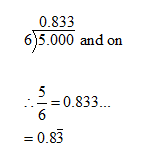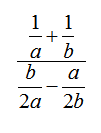Changing a Decimal to a Fraction 6-6
As we have seen, every fraction is equal to either a
terminating decimal or a repeating decimal. It is also true that every terminating
or repeating decimal is equal to a fraction.
To change a terminating decimal to a fraction in lowest
terms, we write the decimal as a fraction whose denominator is a power of 10. We
then write this fraction in lowest terms.
Change 0.385 to a fraction in lowest terms
0.385 = 385/1000 = 77/200
Change 3.64 to a mixed number in simple form
We discovered that some fractions became repeating decimals.
For example
4/9 = 0.444444...
31/99= 0.31313131...
275/999= 0.275275275...
243/999 = 0.243243243...
243/999 = 0.243243243...
and we found that you could write these with a vinculum.
so
We talked about the 9th's family.... and found the simple rule for changing a single digit decimal with the vinculum over it...
and then we saw that
and
but we discovered that using our divisibility rules we could simplify 45/99 to 5/11
We then talked about the wonderful 11th's family and found the simple rule for changing those special fractions.
That that point we talked about
Again, using our divisibility rules we found we could simplify 243/999 because we saw that both the numerator and the denominator were divisible by 9. At that point we find that 243/999 = 27/111 But then we realize that both the numerator and the denominator are still divisible by 3. so we can simplify the fraction to 9/37.
This discussion continues with our next class! I can't wait! How about you?


























